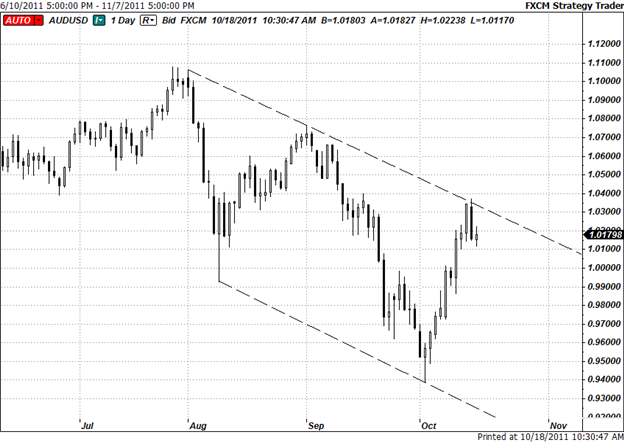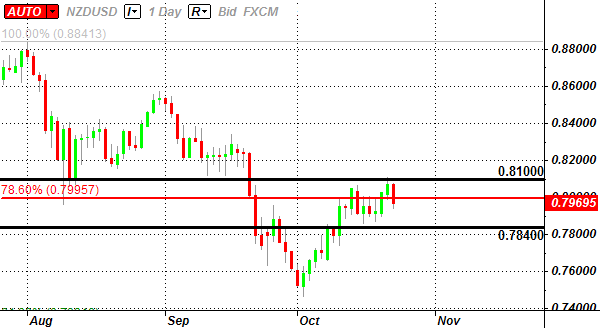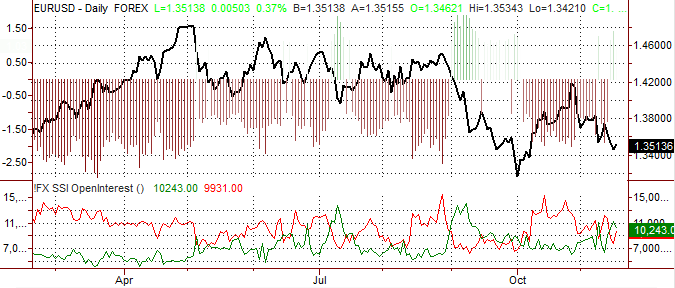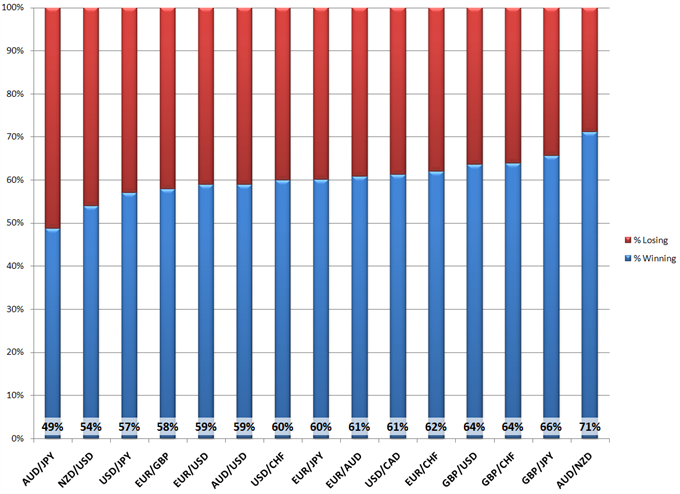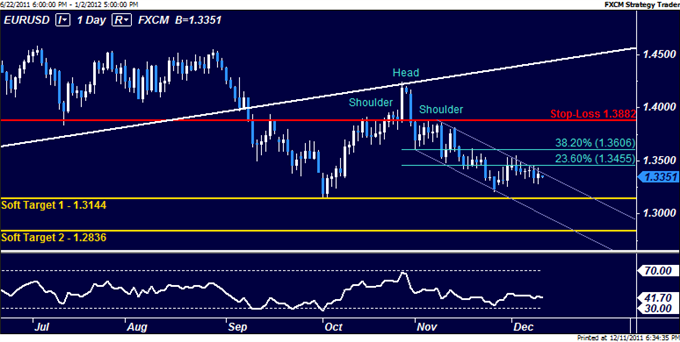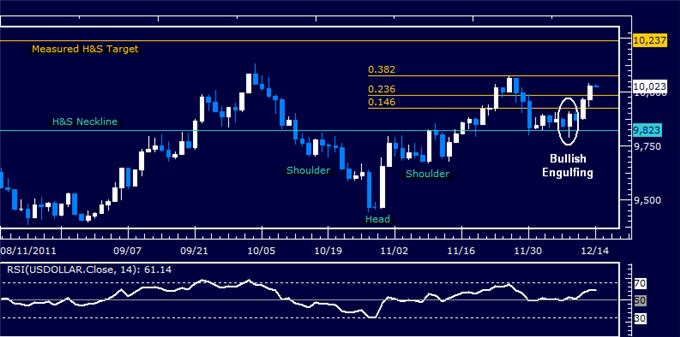[B]Focus Turns Towards Central Banks, G-20 Summit[/B]
[B]Written by Christopher Vecchio of DailyFX[/B]
Ahead of Thursday’s enormous rally in risk-correlated assets, net short interest on the New York Stock Exchange had reached its lowest level in two-months. After the rally this past week, I think it’s safe to say that most, if not all of the shorts, have been squeezed out of the market. The move higher inspires confidence, but the reality of the situation in Europe remains dicey at best.
With that said, in terms of scheduled event risk, there are key events on the docket that could prop volatility up over the coming days. Looking ahead to key data releases, the United Kingdom gross domestic product report is of particular interest, especially considering the Bank of England’s move earlier in October to expand its asset purchase facility. Similarly, it is worth noting that the British Pound lagged the risk-rally this past week, and it is of my firm belief that the Pound stands to be one of the worst performers going forward given the stagflating state of their economy. For the major Western hemisphere economies, both Canada and the United States have labor market reports on Friday, and a continuation of recent labor market growth is eyed, especially in light of the recent U.S. gross domestic product reading which showed a 2.5 percent expansion in the third quarter, on an annualized basis.
Among the key data releases, there are three rate decisions this week, all with the potential to catapult risk-correlated currencies back towards their yearly and all-time highs against the U.S. Dollar or stop the risk-rally in its tracks as policymakers maintain their increasingly dovish outlook on the global economy. The Reserve Bank of Australia rate decision kicks off the week of policy meetings on Tuesday, followed by the Federal Open Market Committee meeting on Wednesday and lastly the European Central Bank rate decision on Thursday. The ECB rate decision is noteworthy as it will be incoming president Mario Draghi’s first press conference at the helm of the ECB. Amidst all of the FX market specific event risk is the G-20 meeting in Cannes, France, where global leaders will meet on Thursday to discuss ways to calm markets and stoke growth going forward.
[B][U]AUD Reserve Bank of Australia Rate Decision: November 1 – 03:30 GMT[/U][/B]
The Reserve Bank of Australia will hold its November meeting on Tuesday, where it is expected that the rate will be maintained at 4.75 percent. At the previous board meeting in October, the Reserve Bank of Australia decided to hold the rate steady at 4.75 percent, a level that has remained unchanged since November 2010. According to the Credit Suisse Overnight Index Swaps, there is an 85.0 percent chance of a 25-basis point rate cut at the central bank meeting on Tuesday. Accordingly, 102-basis points are being priced out over the next 12-months, indicating a cut in the rate is coming down the pipe.
A rate cut is a likely scenario, if not at this meeting, at one of the upcoming ones. As per the RBA’s October meeting minutes, the central bank believes that “it was likely that growth over the forecast period would be somewhat slower and that the labor market would be less tight than forecast.” On the same note, they said that “this prospect, as well as the lower starting point for inflation, meant that the inflation outlook appeared less concerning than was the case a few months ago.” Given these observations, it appears that the Reserve Bank of Australia is becoming increasingly dovish. While concerns over the Australian economy are limited in scope, any pullback in Australian growth is likely to be provoked by broader global macroeconomic trends. This has translated into a weaker Australian Dollar over the third quarter of 2011 (at Friday’s close, it was still over 2 percent below its all-time high), as interest rate expectations have deteriorated sharply in recent weeks, a trend that is expected to continue.
[B][U]GBP Gross Domestic Product (YoY) (3Q A): November 1 – 09:30 GMT[/U][/B]
According to a Bloomberg News survey, the United Kingdom economy experienced slower economic growth in the third quarter of 2011 at a pace of 0.4 percent year-over-year, down from 0.6 percent in the second quarter. Data from the second quarter didn’t paint an optimistic picture for the future of the British economy. Exports fell during the second quarter, down 1.3 percent, even as the Sterling was weaker across the board: the Franc rose10.32 percent against the Sterling; the Euro gained2.23 percent against the British currency; and the U.S. Dollar was slightly stronger, up 0.23 percent. The other components of the recent growth reading were hardly encouraging: consumer spending dropped by 0.8 percent in the second quarter, while investment rebounded slightly, up 3.8 percent year-over-year.
Other health barometers of the British economy suggest that growth is likely to slow further in the future. Inflation is now at a 5.2 percent clip as per the most recent reading in September, above the 4.9 percent predicted rate. Recent output data has shown signs of deterioration as well, with industrial production falling by 1.0 percent in August, year-over-year, and manufacturing data falling short of expectations, down to 1.5 percent from 2.6 percent, year-over-year, in August. As such, a lower reading is expected, and a print below the expected figure is not out of the question. Join a DailyFX analyst for live coverage of event!
[B][U]USD Federal Open Market Committee Rate Decision: November 2 – 16:30 GMT[/U][/B]
It is widely anticipated at the Federal Open Market Committee rate decision on November 2 that the Fed Funds rate will be kept unchanged between 0.00 and 0.25 percent. The key part of the meeting to watch will be Federal Reserve Chairman Ben Bernanke’s commentary in regards to the labor market recovery in the United States; now that the U.S. economy has recovered all of its losses in terms of GDP during the recession, the focus is squarely on jobs growth.
In the inter-meeting period, rumors have floated that the Federal Reserve is considering another round of quantitative easing, similar to the first round of purchases that were intended to prop up the struggling housing market. This will likely be discussed at the meeting on Wednesday. However, the economic climate is slightly different now than it was this time last year. In fact, while deflation was a major concern, inflation in the United States moved higher to 3.9 percent year-over-year in September, a clear sign that prices are unstable. Considering many have ridiculed the bond purchase program due to its tendency to inflate prices on a nominal basis, the additional round of easing will have many dissenters, including some within the Federal Reserve. The FOMC meeting will be the most important event of the week, as it appears policymakers will need to be increasingly creative in the periods ahead to stoke growth. Join a DailyFX analyst for live coverage of event!
[B][U]EUR European Central Bank Rate Decision: November 3 – 12:45 GMT[/U][/B]
The European Central Bank is expected to keep its key interest rate unchanged at 1.50 percent at its meeting on November 3. The Credit Suisse Overnight Index Swaps have eased off their bias towards a rate cut in the future during the inter-meeting period, supporting broad market speculation. Currently, markets are pricing in a 20.8 percent change of a 25.0-basis point rate cut. Similarly, there are 21.5-basis points being priced out of the Euro for the next 12-months. In recent weeks, interest rate expectations have risen for the Euro, and as recently as October 4 markets were pricing in a 100.1 percent chance of a 25-basis point rate cut.
This coming meeting is of particular interest, considering the fact that this is incoming European Central Bank president Mario Draghi’s first meeting as head of the central bank. Mr. Draghi has been handed a precarious situation, but he has already shown that he has the courage to speak out about the roots of Euro-zone problems, including political problems. For example, on Thursday, Mr. Draghi wrote an opinion piece in the German daily Handelsblatt, in which he stated said that Italian leaders are “wavering and hesitant” and that the “ongoing crisis has a worldwide and a European dimension, but the particular vulnerability of Italy has national reasons.”
The most important aspect of Mr. Draghi’s new job is monetary policy, and here there could be some changes.I expect that much will remain in place from the previous regime, at least in the beginning as the ECB will likely move forward with its unconventional bond buying and to continue providing unlimited liquidity to European banks. However, Mr. Draghihas indicated that these measures are “temporary by nature,” so some of Mr. Trichet’s last few policies may be short-lived.
The big question is what Mr. Draghi will do with the ECB’s key interest rate, which Mr. Trichet daringly decided to raise twice earlier this year. The broad Euro-zone economy is slowing, and even Germany has shown signs of slower growth. Theoretically, a lower interest rate should boost economic growth as well as lower the borrowing costs for Euro-zone governments.Both developments would be welcomed. On the other hand, inflation in the Euro-zone overall is above 3.0 percent year-over-year;a rate cut may increase price pressures. All things considered, I think that the ECB is unlikely to alter monetary policy until early 2012 at the earliest, if it chooses to alter it at all.Join a DailyFX analyst for live coverage of event!
[B][U]USD Change in Non-farm Payrolls (OCT): November 4 – 12:30 GMT[/U][/B]
According to a Bloomberg survey, economists have forecasted that October data will show an increase of 95K in U.S. nonfarm payrolls figure, the American index of the labor market. The September figure came in at a surprising103K print, well-above expectations.Recent growth data has show that the American economy resumed growth in the third quarter, with the economy growing at a 2.5 percent annualized rate over the period; if growth trends continue to rebound, corporate profits may increase, prompting a new wave of hiring.
Accordingly, economists expect the rate to remain at 9.1 percent. In July, the unemployment rate dropped to 9.1 percentbeating economists forecast that the rate would hold at 9.0 percent; this level does not look like it will be broken at the coming reading. Confidence remains low as the labor market fails to recover, slipping to 39.8 in October. As such, this data release is the most important event on the economic docket the coming week next to the Federal Open Market Committee rate decision.Join a DailyFX analyst for live coverage of event!
Source: Forex @ DailyFX - Focus Turns Towards Central Banks, G-20 Summit

